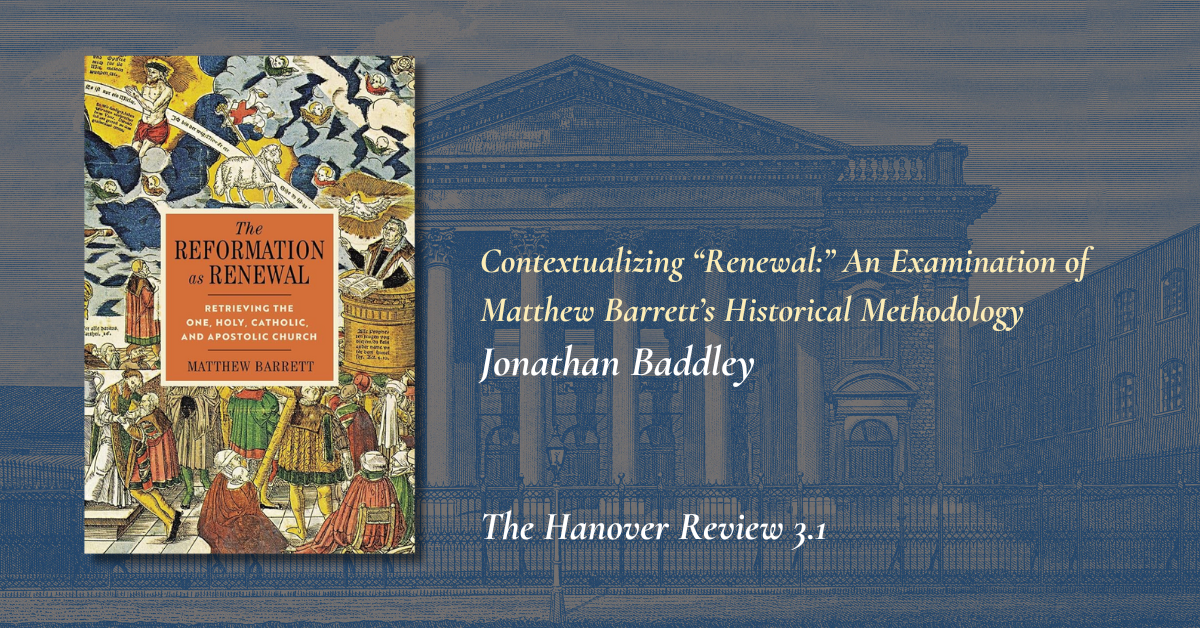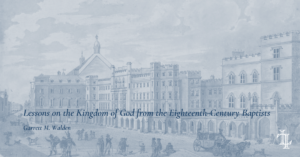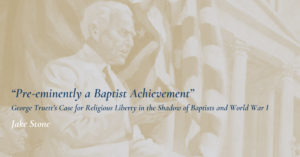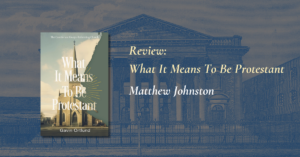Note: This is the online version of an essay from the Hanover Review 3.1 on the Reformation as Renewal Symposium. Print copies are available here and full digital copies of the issue are available here. Full details about the symposium can be found here. More information about the Hanover Review is found here.
1. Introduction
Matthew Barrett’s The Reformation as Renewal is a wide-ranging look at the internal logic of the Protestant Reformation. The book’s main contention is that the Reformation was a project of “retrieval and renewal of the one, holy, catholic, and apostolic church.”1Matthew Barrett, The Reformation as Renewal: Retrieving the One, Holy, Catholic, and Apostolic Church (Grand Rapids: Zondervan Academic, 2023), 3. Barrett makes clear that his is an explicitly historical, rather than theological, study—“an intellectual and theological history of the Reformation”—that argues for the self-conscious catholicity of the Reformers.2Barrett, The Reformation as Renewal, 32 In other words, Barrett has not here concerned himself with whether the Reformers were right, in any meaningful sense, to claim a direct connection to the universal church, but rather whether “the Reformers themselves interpreted their reform as a renewal of catholicity.”3Barrett, The Reformation as Renewal, 32. The Reformation as Renewal is, therefore, an attempt to understand the Reformers on their own terms.
This essay considers how Barrett prosecutes that argument. Using his chapter on the English Reformation (Chapter 16) as a case study, it examines his method and his sources. Through a consideration of two brief examples—namely, Barrett’s implicit chronology of the English Reformation, and his treatment of English Catholicism—it argues that the book’s lack of engagement with the vast body of English Reformation historiography causes him to reanimate an outmoded historical narrative that misses much of the vibrancy of this era. A sufficient command of the relevant secondary literature on an historical subject gives an author a far wider command of the extant primary material than they would otherwise enjoy and therefore often highlights the complexities of a given period. This is especially important in a project like Barrett’s, which is chronologically, geographically, and thematically expansive. Particularly because Barrett relies exclusively on a tight selection of printed sources, his work would have benefitted from the insights generated by the granular archival work that undergirds many studies from the last several decades. Setting aside the limited primary source base for his argument, much of the history he narrates in the chapter is reliant on a handful of secondary sources, with only a smattering of citations that reference works by historians of the English Reformation (though, curiously, the bibliography at the end of the book is more robust).45. See Barrett, The Reformation as Renewal, 941-44. Despite wanting to understand how the Reformers themselves understood what they were doing, Barrett’s scant use of the relevant secondary literature leads him to detach his historical subjects from their socio-political contexts, causing the book to tend in a distinctly Straussian “great thinkers” direction. This is not helped by the fact that the entire chapter is a chain of prosopographical accounts meant to stand in as an overview of the entire topic.
2. Historiographical Help
At the outset of The Reformation as Renewal, Barrett expresses discontent with the way in which the Reformation is misinterpreted “among the evangelical masses” and even in “Christian universities and seminaries.”56. Barrett, The Reformation as Renewal, 23. The way to ameliorate this problem is surely not to ignore secular scholarship, but to engage it, to use it effectively, and, where necessary, correct it. Indeed, given the frequent debate over the place of confessional allegiance in work on the English Reformation, it is doubly important.6See, e.g., “Focal Point: Post-Confessional Reformation History,” Archiv für Reformationsgeschichte 97 (2006): 276-306. See also, Diarmaid MacCulloch, “Changing Historical Perspectives on the English Reformation: the Last Fifty Years,” in Studies in Church History 49 (2013): 282-302, NB: 292-94. The tight integration of the best secular scholarship in evangelical work makes the evangelical work sharper. In neglecting to utilize these interpretations, Barrett runs the risk of perpetuating the very problems he has identified in his first chapter. For example, without addressing the relevant historiography, it is easier to concoct what historian Quentin Skinner has called a “mythology of coherence,” where the past is pared apart into disparate bits and then reconstituted to present a clear, cogent, and (sometimes) whiggish narrative of inevitable progress that ignores messy inconsistencies and contradictions.7Quentin Skinner, “Meaning and Understanding in the History of Ideas,” in History and Theory 7 (1969): 3-53. In missing the scholarly insights about the period accrued over the last fifty years, it is impossible to make sense of the English Reformation without resorting to just that sort of synthetic account—the subject matter, and the primary material it left behind, is simply too dynamic. The following analysis considers two specific examples from this chapter that evoke the interpretive problems that attend Barrett’s approach to this period.
3. 1571 as Protestant Landmark?
First, a quibble with Barrett’s assertion that the year 1571 “was monumental, representing an irreversible commitment to Protestantism” and the date by which “England and its church were solidified within Protestantism.”8Barrett, The Reformation as Renewal, 813. Though it might be true that the 1570s and 1580s in England were, as historian Patrick Collinson noted, “dominated by a more or less consensual and emphatically Protestant regime,” can we really say, with Barrett, that Protestantism in England was “irreversible” after 1571?9Patrick Collinson, “The politics of religion and the religion of politics in Elizabethan England,” in This England: Essays on the English Nation and Commonwealth in the Sixteenth Century (Manchester: Manchester University Press, 2011), 44; Barrett, The Reformation as Renewal, 813. In some ways, it is exactly the kind of observation we would expect an historian to make. Sitting at a rather safe four centuries’ distance away—and with the benefit of the end of the story—his is an easy assertion. After all, the British King is still Protestant (isn’t he?). It is, however, more difficult to consider post-1571 England unalterably Protestant when canvassing the perspectives of sixteenth and seventeenth century English Protestants.
Such a conclusion ignores the fits and spurts of contention over the relationship England would bear to Catholicism well beyond the 1570s. Here are just a few of the highlights: subsequent decades would see an attempted invasion of England by Catholic Spain (1588), the threat of a Catholic successor to Elizabeth (1580s/90s), a failed Catholic coup (1605), the unsuccessful negotiation of a marriage alliance with Catholic Spain (1614–23), a successful marriage arrangement between King Charles I and a French Catholic Princess (1625), and a debate over the elevated ritualism of the “beauty of holiness” movement in the national church (1620s/30s). Catholicism remained a very real threat to English Protestantism throughout the early Stuart period—or, at the very least, it was perceived that way by English Protestants at the time. Without acknowledging (at least subjective) historical contingency, or the torque that socio-political forces could exert on Protestant self-identity, it is hard to get a real sense of the extent, shape, and nature of early modern English claims to primitivism and catholicity. It is exactly because Barrett fails to address the scholarship of the last several decades that The Reformation as Renewal’s treatment of the English Reformation neglects to account for these forces. The project is simply too gargantuan for any one historian to go it alone.
This concern with one phrase in an almost 1,000-page book proves more serious when considered in light of Barrett’s implicit periodization of this chapter. Given that he has apparently set 1571 as the English Reformation’s terminus ad quem, he misses primary material that captures early English Protestants as they worked out what reformation meant and the shape it would assume in England. While, in retrospect, this may be true with reference to the political instruments of the English Reformation, which Barrett consistently downplays in the chapter, it surely cuts short the processes of social and cultural adoption of the Reformation. Many pressed for “further Reformation” and saw the Elizabethan Settlement as by no means the end of the road—it had, from their perspective, retained too many vestiges of Rome. The job was only half done, and they would have been sorely disappointed to learn that 1571 was curtains for the aims of progressive Protestants. Though Barrett considers this Puritan critique “beyond the scope” of his book, it is not at all clear why.10Barrett, The Reformation as Renewal, 813. Had Barrett followed what has become the prevailing view among many historians of the English Reformation, that England underwent, in some form or fashion, a long Reformation (more on that in a moment), he could have availed himself, for instance, of William Perkins’ important A reformed Catholike (1597)—a loud absence in a chapter on catholicity and the English Reformation.
While he does discuss Perkins’ famous work in the book, he does so some 200 hundred pages earlier, in a paragraph on post-Reformation Reformed catholicity.11 Barrett, The Reformation as Renewal, 605. This would appear to suggest (it is never expressly acknowledged in the chapter) that Barrett has taken on the chronology that Richard Muller has so helpfully sketched with regard to early modern Reformed Protestantism. This chronological frame brackets off the Reformation from the “post-Reformation” by a period of “early orthodoxy,” that stretched (in two phases) from ca. 1565-1640.12Richard Muller, After Calvin: Studies in the Development of a Theological Tradition (Oxford: Oxford University Press, 2003), 4-5. Muller, however, uses these chronological categories to help define and describe, very specifically, the “institutionalization of the Reformation,” the development of Protestant dogma, and the “confessional solidification of Protestantism.”13Richard Muller, Post-Reformation Reformed Dogmatics: The Rise and Development of Reformed Orthodoxy, ca. 1520-1725 (Grand Rapids: Baker Academic, 2003), I:30-31. Barrett has, however, lifted this broad and trans-national frame out of the context in which Muller deploys it, and set it down squarely on religious developments in early modern England. Hence, ca. 1565 (or, 1571), inaugurates the English post-Reformation. What came before then, we are made to surmise, was the English Reformation. While it is certainly possible to make a (strong) case for the efficacy of the category “post-Reformation” after the Elizabethan Settlement—though that case would have to be couched more in political, rather than social, cultural, and religious terms—this is something Barrett neglects to do.14John Spurr, The Post-Reformation: Religion, Politics and Society in Britain 1603-1714 (New York: Taylor & Francis, 2006). Spurr contends that the English “post-Reformation” was inaugurated by James I’s accession to throne in 1603, and thus was a decidedly post-Elizabethan in character.
Setting aside the methodological issues here, Barrett’s use of this periodization completely ignores the historiography of the English Reformation for the last half-century, which has been occupied directly and indirectly with this very question. Barrett’s chronology, in fact, hearkens back to the heady days of the mid-twentieth century, when confessional and nationalistic accounts of the English Reformation ruled the roost. On the whole, these triumphalist readings described an England liberated from the decrepitude of a spiritually ailing medieval church by Henry VIII and his anticlerical allies.15See e.g., G.R. Elton, Reform and Reformation: England, 1508-1558 (London: Harvard University Press, 1977) and A.G. Dickens, The English Reformation (New York: Schocken Books, 1964). Cf. Andrew Pettegree, “A.G. Dickens and his critics: a new narrative of the English Reformation,” Historical Research 77, no. 195 (February 2004): 39-58. Pettegree advances a convincing case that the “historiographical shorthand” used to capture Dickens’ work—“rapid Reformation from below”—seriously misunderstands Dickens’ views. Pettegree writes, “Dickens was fully aware that the English Reformation was a troubled and difficult process, often unloved, often resisted.” The Protestant doctrines of grace and sola scriptura then comprehensively and with haste captured the hearts and minds of the English people. Despite the hiccup of a return to Rome with Queen Mary, once Elizabeth assumed the throne, the Reformation was brought to a tidy close in a tempered Protestant settlement. The whole thing was wrapped up in the span of about thirty or forty years. This seems to be where Barrett lands, and rather unselfconsciously at that. However, in the 1970s, 1980s, and 1990s, a new wave of historians began to poke holes in this account. They argued that much of the English populace was far less discontented with the medieval church than had been previously acknowledged and many had bristled at the introduction of Reformation teachings.16See g., J.J. Scarisbrick, The Reformation and the English People (Oxford: Basil Blackwell, 1984), Christopher Haigh, The English Reformation Revised (Cambridge: Cambridge University Press, 1987), and Eamon Duffy, The Stripping of the Altars: Traditional Religion in England, 1400-1800 (New Haven, CT: Yale University Press, 1992). For the “revisionists,” the English Reformation was a contested, gradual, and by no means linear, process.
More recently, scholars have questioned this “revisionism” as perhaps having gone too far. These “postrevisionists” acknowledge that while the Protestantization of England was neither immediate nor total, it did, nevertheless, result in expeditious and widespread religious change.17See Peter Marshall, “(Re)defining the English Reformation,” Journal of British Studies 48, ( July 2009): 564-586. One feature which has generated a somewhat broad consensus in the field is the contention that the Reformation was a protracted process that extended, at least culturally, well beyond the Elizabethan Settlement.18See e.g., England’s Long Reformation, 1500-1800, ed. Nicholas Tyacke (London: Routledge, 1997). As Collinson argued, “the Reformation was something which happened in the reigns of Elizabeth and James I,” prior to that “everything was preparative, embryonic.”19Patrick Collinson, The Birthpangs of Protestant England: Religious and Cultural Change in the Sixteenth and Seventeenth Centuries (New York: St. Martin’s Press, 1988), ix. Even Peter Marshall, who is less inclined to see the Reformation as something that extended into the seventeenth century, draws his recent account of the English Reformation to a close in Elizabeth’s last decade (1590s).20See Peter Marshall, Heretics and Believers: A History of the English Reformation (New Haven, CT: Yale University Press, 2017), p. xviii. Barrett’s inattention to this historiographical context unnecessarily restricts his discussion of events in England and sets us back in the whiggish narratives of the mid-twentieth century. What he loses in this is the perspective of his historical subjects and the social, political, and cultural contexts in which they defended their connection to the church universal. It thus becomes difficult, in any meaningful way, to assess what the Reformers were doing with their purported catholicity. We run the risk of imposing our own assumptions on these historical agents, rather than carefully considering the concepts, intellectual categories, polemical purpose, and language they had to handle in their own times. This is not to suggest, with the postmodernists, that texts have no real meaning outside of their contexts; only that it becomes much harder to recover a text’s meaning without sufficiently acknowledging the socio-cultural and polemical forces that may have instigated it or shaped its use. Without taking stock of the historiography, Barrett unintentionally adopts an outmoded approach to this period that historians have, to salutary effect, thoroughly revised.
4. English Catholics and Protestant Diversity
Another instance of this kind of atavism is Barrett’s dismissal of the religious impact of Mary’s reign and the place of Catholicism in the story of England’s religious transformation. Ignoring most of the scholarly literature of the last thirty years, Barrett uncritically repeats the argument, propounded most eloquently by A.G. Dickens, that the Marian Counter-Reformation fell on its face and had no lasting impact on what came later.21See e.g., Dickens, The English Reformation, 262, 280. Barrett neglects to consider (apart from a single citation on iconoclasm) Eamon Duffy’s significant The Stripping of the Altars, in which Marian Catholicism is portrayed as decidedly more vigorous than earlier histories had allowed.22Duffy, The Stripping of the Altars. See especially, chapter 16, “Mary,” 524-564. Duffy writes, “[t]here is…considerable evidence that the religious programme of the Marian church was widely accepted, and was establishing itself in the parishes” (526). It signaled the start of a spate of historical work on both the potency and achievement of Catholicism under Mary.23See, e.g., Lucy Wooding, Rethinking Catholicism in Reformation England (Oxford: Oxford University Press, 2000). Cf. John Bossy, The English Catholic Community, 1570-1850 (London: Darton, Longman and Todd, 1975). Bossy’s influential earlier treatment of this topic made a persuasive case that it was not Mary’s reign that reinvigorated English Catholicism, but rather the work of Jesuit missionaries from the Continent. As Peter Marshall has concluded, from Mary’s interstitial rule there emerged “a more articulate, combative and committed Roman Catholicism.”24Marshall, Heretics and Believers, 415. For Barrett, though, the reinstitution of Catholicism in the 1550s “was merely external” and “could not reverse the heartfelt religious commitments of the English people overnight.”25Barrett, The Reformation as Renewal, 803. On this reading, we meet once more an adamantine Protestantism that had taken root quickly, spread immediately throughout England, and was impervious to the wiles of Rome. Additionally, though Barrett mentions Catholic recusancy under Elizabeth, his 1571 endpoint serves as a blinder for the helpful work by historians that have traced the persistence of English Catholicism into the seventeenth century. He fails to engage with any of the (relatively) recent work on that share of nondescript English Catholics who neither nominally adopted Protestantism, nor engaged in outright recusancy.26See Alexandra Walsham, Church Papists: Catholicism, Conformity and Confessional Polemic in Early Modern England (Woodbridge: The Boydell Press, 1999) and Michael Questier, Catholicism and Community in Early Modern England: Politics, Patronage and Religion, c. 1550-1640 (Cambridge: Cambridge University Press, 2006). If Protestantism was unalterably entrenched by the start of Elizabeth’s reign, no one told English Catholics. Given the course of events at the end of the sixteenth and beginning of the seventeenth centuries, English Protestants would have been surprised by this too.
Not to mention, Barrett’s picture of the English Reformation completely ignores the inner turmoil, debate, and diversity of opinion that existed within English Protestantism itself. As a significant body of work, including that by Patrick Collinson, Peter Lake, and, more recently, Karl Gunther, has shown, sixteenth century English Protestantism was far from the placid monolith we find in The Reformation as Renewal.27See, e.g., Peter Lake and Michael Questier, The Antichrist’s Lewd Hat: Protestants, Papists & Players in Post-Reformation England (New Haven, CT: Yale University Press, 2002) and Karl Gunther, Reformation Unbound: Protestant Visions of Reform in England, 1525-1590 (Cambridge: Cambridge University Press, 2014). Its shape, nature, and relation to Catholicism were incredibly contested from within during the early modern period. Yet Barrett’s (silent) repackaging of a mid-twentieth century progressivist narrative misses these insights, as well as those set forth in other perceptive recent studies that address the incongruities and key tensions of the Reformation in England. Within English Protestantism in this period there existed an array of ideas about what continuity with the universal church, especially the early church, could mean. Polemically, and it seems earnestly, all types of English Protestants strove to connect themselves to what came before. But they could mean very different things in doing so—ecclesiologically, ceremonially, hermeneutically, and soteriologically, the past to which they laid claim was often made to service their convictions. Anthony Milton has traced the shape of these differences in the early Stuart period, laying out the multiple pasts to which various Protestant constituencies claimed lineage.28Anthony Milton, Catholic and Reformed: The Roman and Protestant Churches in English Protestant Thought, 1600-1640 (Cambridge: Cambridge University Press, 1995). See especially chapter 6, “Visibility, succession and the church before Luther,” 270-321. See also Theodore Dwight Bozeman, To Live Ancient Lives: The Primitivist Dimension in Puritanism (London: University of North Carolina Press, 1988). Bozeman considers how the Puritans connected themselves to earlier periods of church history. This diversity in English Protestant belief did not spring up sui generis after Elizabeth’s death. Rather, as Gunther’s Reformation Unbound demonstrates, there existed a “spectrum of voices” among Protestants in the “early English Reformation.”29Gunther, Reformation Unbound, 15. These early evangelicals bickered over both the interpretation and implementation of many aspects of ancient church praxis. This discord did not evade the watchful eyes of their Catholic opponents, who took a particular satisfaction in arguing, as John Standish did in 1554, that “scantly two of them have in all points well agreed together.”30John Standish, A discourse wherin is debated whether it be expedient that the scripture should be in English (London, 1554), a6r. In examining the internecine squabble that arose among the Marian exiles in Frankfurt in the 1550s, Gunther rightly notes that just this sort of Catholic attack impacted the shape of the argumentation over the use of the Edwardian prayer book among English Protestants in exile.31See, g., Gunther, Reformation Unbound, 169. Thus, the Reformers’ claims to catholicity cannot be siloed off from the broader polemical context(s) in which they were made. So the question, with regard to England at least, may not simply be were the Reformers catholic? but rather what did their catholicity mean?
Furthermore, though Barrett chides (unnamed) historians for arguing that “the success of the English Reformation was merely a product of politics,” he engages in just this sort of reductionism in his account of early modern English Catholicism.32Barrett, The Reformation as Renewal, 771. On Barrett’s reading, from its outset in the early sixteenth century, the religious change wrought by the Reformation was precipitous, univocal, and total, such that by the time Mary acceded to the throne, a permanent return to Rome was unthinkable. Though political context has been written almost entirely out of his account of the rise of English Protestantism, “Mary’s reversal of evangelical reformation” was simply “from the top down,” mere “religious legislation” that could not “finally penetrate the hearts of the English people in a lasting way.”33Barrett, The Reformation as Renewal, 809. Although Barrett never explains quite why politics was the driver of Marian Counter-reformation but not of the Protestantization of England, we are left to wonder whether his personal religious commitments have led him to assume the latter was genuine because it is theologically true. If so, this of course sits at odds with his disciplinary orientation in the book—he is clear that in The Reformation as Renewal he is not answering a “theological” question, but a “historical” one.34Barrett, The Reformation as Renewal, 3. His evangelical perspective is refreshing (edifying, even!), but it should not obscure the complexities of the period— complexities that have been thoughtfully discovered and considered in the secondary literature. Here again, Barrett’s inattentiveness to the relevant historiography yields a simplistic account of dynamic events.
The most important concern here is not that Barrett gives an account of the English Reformation that is at odds with various aspects of the scholarship of the last thirty years. He is of course entitled to present his own interpretation of these events. Importantly, too, his is not a book on the English Reformation, and he is obviated in large measure of the responsibility of handling the minutiae of the historiographical debates that occupy scholars in the field. Rather, the concern is that he does not engage with this scholarship in any meaningful way, which suggests a larger problem in his methodology. To disagree with key aspects of the prevailing secondary literature is one thing; to go it alone, quite another. Without taking stock of the insights generated by the last half-century, Barrett has no help in understanding the Reformers on their own terms. It is hard to mount a convincing historical case about the English Reformers while leaving unacknowledged the major scholarship on the English Reformation. An evaluation of how he handles the relevant historiography in the other chapters of the book is best left to others. This essay has simply been a “spot check,” as it were, of the methodological approach and historical framing of the larger project. For this chapter, at least, Barrett has made it difficult to see things—in any detail—from the Reformers’ perspective(s), and readers are left with an incomplete assessment of the extent, form, and nature of the claims of English Reformers to catholicity.
5. Conclusion
Though it is certainly true that the Reformers saw themselves as the progeny of the primitive church, it is essential to consider their claims in polemical context. What else could they do? They had to raise the banner of antiquity. Novelty was a vice—an attack used to good effect by their Catholic enemies. So though there is enough evidence to argue with integrity, as Barrett so helpfully does, that the Reformers did indeed see themselves as “renewing” or, to preserve the eponym, “reforming” the church, we cannot uncritically appropriate their texts. We must acknowledge the social, legal, and political pressures under which they wrote. Texts have contexts and we ignore them at the peril of our historical interpretation. Without engaging the brilliant work of the last half-century, it is far harder to truly understand the Reformers on their own terms, good intentions notwithstanding.
Not wishing to end this essay on a critical note, it is important to conclude with a word of thanks to Dr. Barrett for having the pluck to take on this expansive project. While the foregoing takes issue with his approach to one corner of the Reformation, it is essential to commend his broader argument—that the Reformers did indeed see themselves as renewing the true church. This essay has only been concerned with how he makes that argument. He has served both the church and the academy well in offering a coherent account of the lines of connection, real or aspirational, between that religious phenomenon of the sixteenth century that we have come to call the “Reformation,” and the Christian history that preceded it. Hopefully, his valiant effort here will be the start of a long and fruitful conversation that crosses the often too rigid divide between evangelical and secular scholarship.
Author
-

Jonathan Baddley is a PhD student at Cambridge University, serves as the Reformation theology editor for the London Lyceum, and as Senior Editor for Confessional and Historical Theology at Hanover Press. While focused broadly on the progress of the Protestant Reformation in 16th and 17th century Europe, he is especially interested in ecclesiology and church discipline in post-Reformation England. He is writing a dissertation on preparation for the Lord’s Supper in the long 17th century. He has a forthcoming essay in Church History entitled ‘Puritanism, Spiritual Kinship, and the Lord’s Supper in Elizabethan and Early Stuart England.’
View all postsRecent Posts



